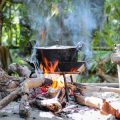Introduction to Foraging in the British Countryside
The soft hush of a dewy morning, hedgerows bursting with hidden treasures, and a gentle breeze carrying the scent of wild garlic—this is the beginning of foraging in the UK. In recent years, more people across Britain have been drawn to the age-old practice of gathering wild food, seeking not just sustenance but connection: to place, to season, and to memory. For bushcraft beginners, foraging offers an enchanting gateway into the natural world, inviting us to slow down and rediscover the abundance that flourishes at our feet. Whether along a winding Cotswold lane or beneath ancient Scottish oaks, the British countryside reveals itself as a living larder. With every blackberry picked or mushroom spotted, we step into a tradition both deeply rooted and newly revived—one that celebrates curiosity, respect for nature, and the quiet pleasures of gathering what grows wild.
Essential Foraging Safety and the Law
Foraging in the UK is not just about discovering hidden edible treasures; it’s also about treading lightly on the land, respecting both nature and the law. Bushcraft beginners must take care to forage responsibly, ensuring their actions preserve the natural beauty and delicate balance of the British countryside for generations to come. The following guidance will help you forage safely, ethically, and legally.
Respecting Nature and Sustainable Foraging
Responsible foraging starts with a deep respect for wild spaces. Always harvest sparingly—never take more than you need, leaving enough behind for wildlife and plant regeneration. Avoid uprooting entire plants unless absolutely necessary, and use clean tools to prevent spreading disease between plants. Stick to well-trodden paths where possible to minimise your impact on fragile habitats, especially during nesting seasons or when wildflowers are in bloom.
Recognising Protected Species
The UK is home to several protected species of plants and fungi. Picking these can damage local biodiversity and may be illegal. Familiarise yourself with species that must not be collected. When in doubt, err on the side of caution and leave unknown or rare specimens undisturbed.
| Protected Species (Examples) | Status | Notes |
|---|---|---|
| Bluebell (Hyacinthoides non-scripta) | Protected under Wildlife and Countryside Act 1981 | Illegal to uproot or sell wild bluebells |
| Lily of the Valley (Convallaria majalis) | Protected in some regions | Toxic if ingested; do not collect |
| Certain Orchids (e.g., Bee Orchid) | Strictly protected | Never pick or disturb |
Understanding UK Foraging Laws and the Countryside Code
British foraging laws are nuanced. While you may forage common wild foods for personal use on public land or with landowner permission, it is generally illegal to uproot plants without consent or to forage commercially without a licence. The Countryside Code provides further ethical guidelines—close gates behind you, avoid disturbing livestock, leave no trace, and take litter home. Some areas, such as nature reserves or Sites of Special Scientific Interest (SSSIs), may prohibit foraging altogether.
Key Points from the Countryside Code
- Be considerate: Respect other people’s enjoyment of the outdoors.
- Protect the environment: Leave what you find; avoid damaging walls, fences, or habitats.
- Control dogs: Keep pets under close control around wildlife and livestock.
- Avoid fire risk: Never light fires or barbecues in sensitive areas.
- Follow local signage: Observe any site-specific restrictions or advice.
Your Forager’s Checklist
- Identify plants confidently before picking—when in doubt, leave it out.
- Avoid protected species and respect local by-laws.
- Harvest only what you can use; never strip an area bare.
- Seek landowner permission if foraging on private land.
- Tread carefully—your footsteps should leave no mark upon this ancient landscape.
Tuning into these legalities and courtesies ensures that every basketful of wild food is gathered with gratitude—for yourself, for fellow foragers, and for the flourishing life of the British countryside itself.

3. Iconic Edible Wild Plants of the UK
Embark on a sensory journey through the heart of Britain’s countryside, where ancient hedgerows weave between meadows and woodland edges, each brimming with edible treasures. Here, the landscape is not just a vista but a living larder, offering up quintessential wild plants whose delicate flavours and fragrances have graced rural tables for generations.
Wild Garlic: The Woodland Perfume
In early spring, the air beneath shady canopies is often scented with the unmistakable aroma of wild garlic (Allium ursinum). Its lush, green leaves carpet the forest floor, and when crushed between your fingers, release a garlicky perfume that stirs the senses. Harvested thoughtfully, these leaves bring a vibrant punch to soups, pestos, and savoury tarts—a true taste of British woodlands in bloom.
Nettles: The Humble Powerhouse
Along winding lanes and beneath tangled hedgerows, nettles (Urtica dioica) await those willing to don gloves and gather their young tops. Despite their sting, nettles are a bushcraft favourite—brimming with nutrients and surprisingly mellow once cooked. Blanched into soups or brewed as a bright herbal tea, they evoke the freshness of spring rain and newly turned earth.
Elderflower: A Midsummer Dream
As May turns to June, elder trees (Sambucus nigra) burst forth with clouds of creamy blossoms—elderflowers—whose sweet scent drifts on warm breezes. These delicate heads are cherished for infusing cordials and sparkling drinks, capturing the very essence of an English summer afternoon. Foragers know to gather them early in the day when their aroma is at its peak, turning ordinary moments into celebrations of seasonality.
Other Quintessential Finds
The British landscape offers more than these classics—wood sorrel’s lemony tang, hawthorn leaves’ nutty undertones, and fat hen’s spinach-like richness all invite exploration. Foraging here is an invitation to slow down and savour the shifting tapestry of nature through sight, scent, and taste—a gentle reminder that our wild spaces are both beautiful and bountiful.
4. Recognising Britain’s Woodland Fungi
The British woods are, in autumn especially, a tapestry of shadow and light, where the scent of damp earth rises from underfoot and the slow, quiet magic of fungi reveals itself. For those stepping into bushcraft foraging, learning to recognise our native mushrooms is an atmospheric adventure – one filled with delight, but also with care, as many edible species have notorious lookalikes.
An Atmospheric Encounter: Edible vs. Poisonous Fungi
Picture yourself wandering beneath the arching boughs of an ancient beech or oak; amidst the mossy trunks and leaf litter, you might spot the nutty hazel bolete, its cap like warm suede, a subtle contrast to the haunting scarlet domes of fly agaric – beautiful but deadly. The air is tinged with earthy sweetness and a touch of caution.
Common Edible and Poisonous Woodland Fungi
| Fungi Name | Edibility | Key Features | Foragers Notes |
|---|---|---|---|
| Hazel Bolete (Leccinum scabrum) |
Edible | Tawny-brown cap; pale stem with dark flecks; found under birch or hazel. | Mild flavour; cook thoroughly; avoid if base turns blue-black when cut. |
| Penny Bun (Cep) (Boletus edulis) |
Edible | Bread-like brown cap; thick white stem; spongy underside. | Cherished in British kitchens; beware similar-looking bitter boletes. |
| Fly Agaric (Amanita muscaria) |
Poisonous | Striking red cap with white spots; white gills and stem. | Avoid entirely; classic fairytale mushroom but highly toxic. |
| Death Cap (Amanita phalloides) |
Deadly Poisonous | Pale olive-green cap; white gills and stem; often found near oaks. | Never pick unknown Amanitas; responsible for most fatal poisonings in Britain. |
| Chanterelle (Cantharellus cibarius) |
Edible | Golden yellow; trumpet-shaped; fruity aroma. | Sought after by chefs; be sure not to confuse with false chanterelles. |
Sensory Foraging: Trust Your Senses and Respect Tradition
A successful forager trusts their senses – the gentle firmness of a cep beneath your fingers, the subtle apricot scent of chanterelles, the thrill of discovery tempered by healthy caution. Always consult a local field guide or join an experienced group before tasting wild mushrooms. In Britain’s woodlands, foraging is both a personal ritual and a continuation of generations-old tradition: tread lightly, take only what you need, and leave enough for wildlife and fellow wanderers. Each encounter is a lesson in patience, respect, and reverence for nature’s hidden larder.
5. Essential Kit for Foraging and Bushcraft Beginners
Embarking on a foraging journey across the British countryside is as much about preparation as it is about discovery. Whether you’re gathering wild garlic in ancient woodlands or seeking chanterelles on misty mornings, having the right kit elevates both safety and enjoyment. Here’s a thoughtfully curated list of must-haves, inspired by the traditions of seasoned UK foragers.
The Classic Wicker Basket
A well-crafted wicker basket isn’t just charmingly rustic; it’s practical too. The open weave keeps your finds fresh, while the gentle structure avoids bruising delicate berries and mushrooms. Many UK foragers favour sturdy, locally-made baskets—often handed down through generations, each carrying stories of past seasons’ bounty.
Reliable Field Knife
No bushcraft beginner should set out without a reliable field knife. Opt for a folding blade with a locking mechanism or a fixed blade with a sheath—both are trusted by British foragers for their versatility and safety. Use your knife to carefully cut stems, avoiding unnecessary damage to plants and fungi so that nature may replenish itself for future gatherings.
Weathered Guidebook
There’s something inherently romantic about thumbing through a dog-eared guidebook as morning mist clings to hedgerows. Select a pocket-sized, waterproof identification guide focused on British flora and fungi. Look for books with detailed illustrations, seasonal notes, and local folklore—these become treasured companions on every ramble.
Additional Handy Tools
- Gloves: Protect your hands from nettles, brambles, and prickly undergrowth.
- Small Trowel: Useful for careful digging when harvesting roots like wild parsnip or burdock.
- Pouches & Paper Bags: Carry separate containers to avoid cross-contamination between species, especially vital when collecting fungi.
Ethical Essentials
Every responsible forager carries an ethical code: harvest only what you need, leave enough for wildlife, and always positively identify your finds before consuming. Consider packing a small notepad to jot down locations and observations—this mindful practice deepens your connection with the land and ensures sustainable gathering year after year.
Together, these items form more than just a toolkit—they become trusted companions, weaving practicality with tradition as you wander Britain’s green ways in search of edible treasures.
6. Seasonal Foraging Calendar
There is a gentle magic in tracing the slow turning of Britain’s seasons through the wild bounty found at your feet. Each month brings its own treasures, and with a mindful eye, every ramble can become a celebration of the living landscape.
Spring: Awakening Abundance
As winter’s chill fades, delicate green shoots unfurl in woodlands and hedgerows. Seek out wild garlic carpeting damp woods, its aroma unmistakable, and young nettles—perfect for soups if handled with care. Early blossoms like blackthorn herald sloe berries for autumn’s harvest, while tender dandelion leaves add zest to spring salads. Always pick sparingly, ensuring there’s plenty left for wildlife and future growth.
Summer: Nature’s Larder in Full Flow
The long days of summer brim with edible delights. Elderflowers bloom in June, ideal for cordials or fritters. Meadows yield meadowsweet and yarrow, while shaded paths offer wood sorrel’s lemony bite. By late summer, brambles are heavy with blackberries—an irresistible treat for children and adults alike—and cherry plums glow along rural lanes. Remember, always gather away from busy roads and pesticide-sprayed fields for the purest flavours.
Autumn: A Wild Harvest Festival
This is the season of abundance, marked by golds and russets as trees shed their leaves. Hedgerows burst with rosehips and hawthorn berries; woodlands gift sweet chestnuts and earthy fungi like chanterelles and field mushrooms (always double-check identifications). Beech nuts crunch underfoot, perfect for toasting over a campfire on crisp afternoons. Let each walk be guided by curiosity and care—never take more than you need.
Winter: Subtle Rewards
Though quieter, winter holds subtle joys for the observant forager. Velvet shank mushrooms cling to frosted logs; sea buckthorn berries brighten coastal walks with their vibrant orange hue. Cleavers’ wiry stems persist through mild spells, ready for tea or salad greens come early spring. Even now, nature whispers its secrets to those who tread softly.
Tips for Year-Round Foraging Success
Know your patch: Revisit favourite spots across seasons to witness nature’s rhythms.
Be weather-wise: Wet days reveal fungi; sunny spells bring out flowers.
Keep a diary: Note timings of blooms and fruiting to plan future outings.
Tread lightly: Leave no trace, respect habitats, and forage responsibly.
Savour the Journey
The joy of British foraging lies not just in gathering wild food but in feeling attuned to the land’s quiet transformations—a celebration of each fleeting season beneath ever-changing skies.
7. Foraged Flavours: Simple Ways to Enjoy Your Finds
After the gentle thrill of wandering through hedgerows and woodlands, baskets brimming with nature’s bounty, comes the quiet pleasure of weaving these wild treasures into everyday meals. The UK countryside offers a palette of edible plants and fungi just waiting to be transformed into dishes both humble and heartwarming.
Celebrating British Classics
Perhaps nothing says “British bushcraft” quite like nettle soup. Young, tender nettles—once properly blanched to tame their sting—create a nourishing green broth that sings with spring’s promise. Simply sauté onions and garlic in butter, add a heap of washed nettle leaves, pour in vegetable stock, then simmer until soft. A swirl of cream and a crack of black pepper finish this traditional comfort food.
Elderflower Cordial: Capturing Summer in a Bottle
When elderflowers burst into creamy clouds along country lanes, it’s time for cordial-making—a fragrant ritual beloved across Britain. Gather flower heads on a dry morning, steep them overnight with lemon slices and sugar, then strain and bottle the pale gold elixir. Mixed with sparkling water or drizzled over cakes, elderflower cordial is summer distilled.
Simple Suppers With Wild Greens
Foraged greens such as wild garlic, sorrel, and chickweed can be stirred into omelettes or tossed through salads for a hint of woodland freshness. Try adding wild garlic leaves to mashed potatoes or folding them into homemade bread for an aromatic twist on familiar fare.
Mushrooms: Woodland Umami
If you’re lucky enough to find field mushrooms or chanterelles (always double-check your identification!), gently fry them in butter with thyme and serve atop toasted sourdough—a breakfast worthy of any country cottage.
Tips for Weaving Wild Food Into Daily Life
- Start small: Add one new foraged ingredient at a time to your favourite recipes.
- Keep it simple: Let the flavours shine by using minimal seasoning and preparation.
- Share with friends: There’s joy in swapping recipes and stories around the table.
Foraging invites us to slow down, savour the seasons, and rediscover our connection to the land. Whether you’re sipping elderflower cordial in dappled sunlight or ladling out steaming bowls of nettle soup on a rainy evening, each mouthful is a celebration of Britain’s wild abundance—a feast for both body and soul.


